
Exploring ESD Flooring Options for Electronics Manufacturing & Handling Applications
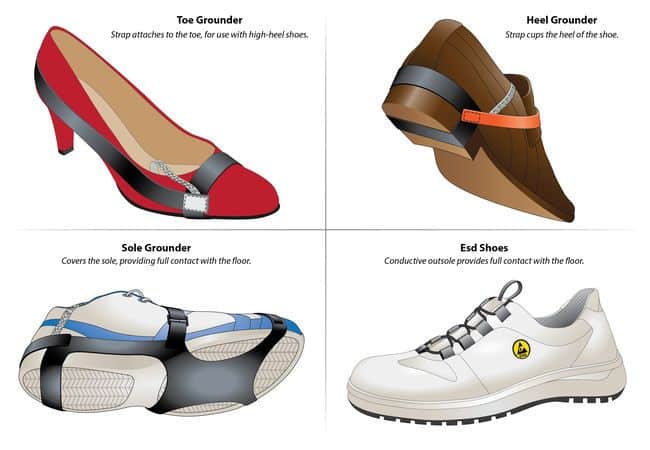
For electronics manufacturing and handling facilities, ESD standard S20.20 requires the use of ESD-protective footwear. Acceptable ESD footwear includes conductive heel straps, toe straps, sole straps and ESD shoes.
The conductive elements in ESD-protective footwear bond with the conductive elements in the floor, creating a reliable ground connection and protecting the wearer against potential shocks on an overly conductive floor. This allows for a wider range of acceptable flooring choices.
Please note: Since this is all about 20.20 and electronics manufacturing, it should be assumed that ESD footwear will be used.
Recommended ESD Flooring Options
- Rubber tile & sheet flooring
- ESD carpet
- GroundLock interlocking or lay-flat tile
- Conductive vinyl
- Some static-dissipative vinyl – if static generation is under 100 volts
- Generation 3 ESD epoxy coatings
NOT Recommended
Non-compliant static-control flooring
- Generation 2 epoxies
- Static-dissipative vinyl measuring above 100 volts per STM97.2
- Vinyl floors with sparse distribution of conductive granules
The electrical performance of these floors is unreliable.
Caution before using
- Any flooring product that relies on antistatic polish or wax for static-control properties
- Static-dissipative vinyl tile or sheet flooring that requires ESD polish or wax to retain static-dissipative properties
Temporary finishes wear off. To ensure compliance with ANSI S20.20, the floor must be tested regularly as well as before and after new applications.
Not static control: Cannot be grounded
- LVT
- Computer-grade (aka low kV) carpet
Ideal, Best Practice
Rubber Tile and Sheet Flooring
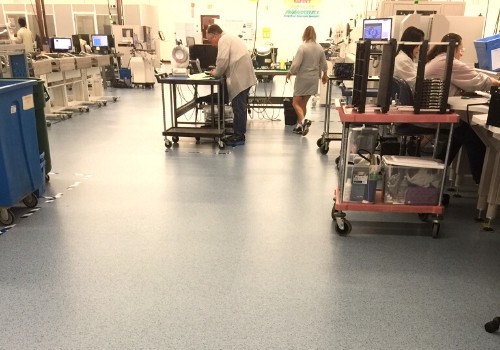
Material cost $$.
Disadvantage: High initial cost.
StaticWorx Eclipse Electrically Conductive (EC) Rubber
Our award-winning Eclipse electrically conductive (EC) rubber is a uniquely fault-tolerant, static-control flooring product. EclipseEC won the Seal of Approval from the ESD Journal as the only product suitable for Class-0 ESD (electrostatic discharge) applications. Associations, universities, labs, consultants, and clients as diverse as ASHRAE, MIT, Dangelmayer Associates, and the ESD Journal have found that conductive rubber flooring offers the lowest charge generation properties of any type of ESD flooring available today. It was also voted a top, money-saving product by Buildings Magazine.
Eclipse Glue Free (GF) rubber, available in rolls, is a self-adhering material that can be installed 24/7 with no adhesives and downtime.
Key Benefits
- No special footwear requirement for mission critical applications
- Meets NASA cleanroom testing
- Low static generating
- Easy to maintain
- Ergonomic
- Superior ESD protection
- Fault tolerant
- Never needs conductive wax
- Reduces explosion risk
- Resistant to chemicals and hot solder
- Slip resistant; complies with ADA guidelines
- PVC and phthalate-free
- Recipient of prestigious ESD Journal Seal of Approval for excellence
- Indoor Air Quality Certified
- Can be seam welded
- No special footwear requirement for mission critical applications
- Meets NASA cleanroom testing
- Low static generating
- Easy to maintain
- Ergonomic
- Superior ESD protection
- Fault tolerant
- Never needs conductive wax
- Reduces explosion risk

- Resistant to chemicals and hot solder
- Slip resistant; complies with ADA guidelines
- PVC and phthalate-free
- Recipient of prestigious ESD Journal Seal of Approval for excellence
- Indoor Air Quality Certified
- Can be seam welded
System resistance: 1.0 x 10E6
2 mm thick, available in 24″ x 24″ tile and 4′ x 40′ rolls
Eclipse GF (Glue Free) Rubber
EclipseGF (Glue-Free) conductive rubber has the ESD properties and benefits as EclipseEC rubber, with a pre-applied, solvent-free, self-adhesive backing. The adhesive backing makes for a quick, easy installation with no messy glue, along with simple maintenance – for the best performance of any resilient ESD flooring.
The preferred choice for almost any environment, EclipseGF rubber offers special benefits for clean rooms and labs, where downtime and contamination can’t be tolerated. It’s also ideal for occupied areas and mission-critical facilities such as server rooms, hospitals, data centers, electronics handling applications, universities, and much more.
Glue-free is hassle-free – for maximum flexibility and convenience. Just roll it on and start walking. Can be applied directly over existing VCT and epoxy.
Key Benefits (GF) – in addition to all benefits of EC rubber
- Reduces installation time
- Provides significant material and labor cost savings
- No moisture or pH limits and no testing required
- Eliminates the complexity of multiple-component suppliers
- Can be seam welded
- No need to spread adhesives or replace worn trowels
- No adhesive open time, allowing for immediate flooring installation
- No topical mitigation system required
- Seamless
- Reduces installation time
- Provides significant material and labor cost savings
- No moisture or pH limits and no testing required
- Eliminates the complexity of multiple-component suppliers
- Can be seam welded
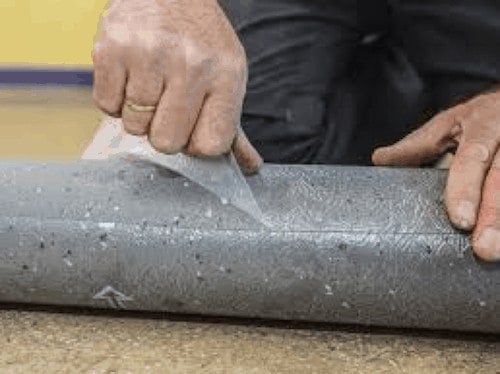
- No need to spread adhesives or replace worn trowels
- No adhesive open time, allowing for immediate flooring installation
- No topical mitigation system required
- Seamless
Interlocking Tiles with high density distribution of conductive granules
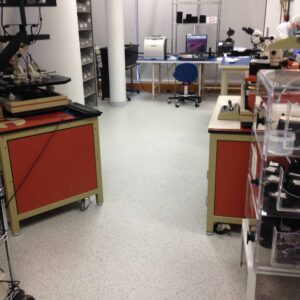
Material cost: $$.
Advantages: Ideal for problem floors, including high-moisture concrete slabs. Easily removed and redeployed.
StaticWorx GroundLock Extreme – Interlocking and Lay-flat tiles
GroundLock Extreme ESD Interlocking and Lay-flat ESD tiles are installable over any sub-floor, with no disruption and no permanent commitment. Unlike most tile, our GroundLock interlocking ESD vinyl tiles can be installed without adhesives and are dimensionally stable (without full adhesion). Our GroundLock tiles are also available as cut, flat-edge tiles* for seam-welding or one-to-one installation over raised access floor panels.
GroundLock Extreme meets all aspects of ANSI/ESD S20.20. Perfect for labs, clean rooms, R&D, and electronics manufacturing and handling spaces.
Key Benefits
- Dimensionally stable
- Never domes or rolls
- Invisible seams
- Lock-together withstands heavy loads up to 30,000 pounds
- Easy rolling heavy loads – no warpage
- Recycled content
- Easily installed in occupied spaces
- Lifetime warranty
- Meets ANSI/ESD S20.20
- Odorless, quick installation
- Slip resistant
- No special sub-floor prep required
- Can be walked on/used immediately
- Never needs wax
- Easy to clean, maintain, and repair
- Available in 24" x 24"
- Dimensionally stable
- Never domes or rolls
- Invisible seams
- Lock-together withstands heavy loads up to 30,000 pounds
- Easy rolling heavy loads – no warpage
- Recycled content
- Easily installed in occupied spaces
- Lifetime warranty

- Meets ANSI/ESD S20.20
- Odorless, quick installation
- Slip resistant
- No special sub-floor prep required
- Can be walked on/used immediately
- Never needs wax
- Easy to clean, maintain, and repair
- Available in 24" x 24"
Charge generation: < 100 volts
Thickness: .24” (6mm)
Size: Interlocking: 25” x 25” (635mm)
Lay Flat: 24” x 24” (610 mm)
ESD Carpet Tile
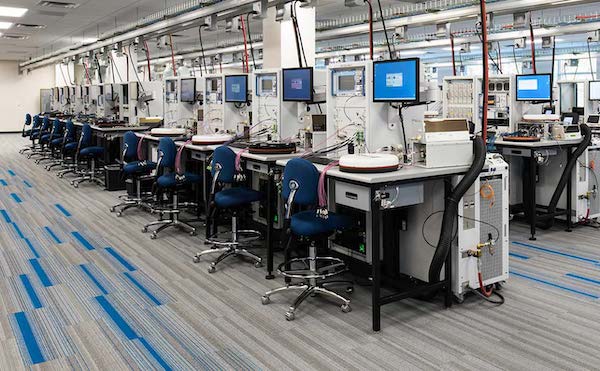
Material cost: $.
Disadvantage: Soft surface, not suitable for certain wet process areas in electronics manufacturing.
ShadowFX Static-dissipative Carpet Tile
Facilities managers for call centers, 9-1-1 dispatch operations, flight towers, control rooms, broadcasting stations, casinos, financial institutions, and government and other networked offices and telecom spaces, have long appreciated the benefits of carpeted floors. Sound attenuation and ergonomics, combined with the ease and low cost of cleaning made carpet an obvious choice for end-user applications.
Key Benefits
- Safe, High-performance Static Control
- Durable
- Reliable
- Convenient
- Easy to clean and maintain
- Can be installed non-directionally
- Ideal for raised access floors
- Mergeable dye lots
- Can be installed glue-free
- 24/7 installation possible
- Safe, High-performance Static Control
- Durable
- Reliable
- Convenient
- Easy to clean and maintain

- Can be installed non-directionally
- Ideal for raised access floors
- Mergeable dye lots
- Can be installed glue-free
- 24/7 installation possible
All Staticworx ESD Carpet Tile and Planx measure in the static-dissipative range:
Electrical Resistance: 10E5 – < 1.0 x 10E9, with 100 V applied voltage, per ANSI/ESD STM 7.1.
Charge generation, measured in volts: < 100 volts (.1kV)
Conductive Vinyl Tile
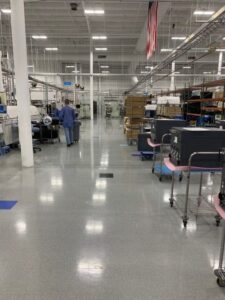
Material cost: $.
Disadvantage: Conductive vinyl is not a low static-generating material; this means it won’t inhibit static from building on people as they walk in street shoes (walking body voltage). Without the use of static-control footwear options, like heels straps or booties, a conductive vinyl floor will actually generate static events.
Due to its static-generating base material and sparsity of conductive particles, static-dissipative (SD) vinyl tile and sheet goods often measure above 100 volts, tested according to STM97.2. SD vinyl measuring above 100 volts does not meet ESD requirements for electronics manufacturing and handling applications.

Material cost: $.
Disadvantage: Conductive vinyl is not a low static-generating material; this means it won’t inhibit static from building on people as they walk in street shoes (walking body voltage). Without the use of static-control footwear options, like heels straps or booties, a conductive vinyl floor will actually generate static events.
Due to its static-generating base material and sparsity of conductive particles, static-dissipative (SD) vinyl tile and sheet goods often measure above 100 volts, tested according to STM97.2. SD vinyl measuring above 100 volts does not meet ESD requirements for electronics manufacturing and handling applications.
AmeriWorx Conductive ESD Vinyl
100% Made in the USA
Precision-milled, each tile is perfectly square and dimensionally stable, for quick installation with no unsightly gaps between the seams. Tough, durable AmeriWorx tiles are rated at 2500 PSI and capable of handling heavy loads – including fork lifts, pallet jacks and heavy machinery.
When installed using our StatBond pressure-sensitive adhesive, AmeriWorx tile handles traffic immediately, with no downtime necessary for adhesive to cure. Inexpensive and easy to maintain, AmeriWorx tile has one of lowest total costs of ownership of any resilient ESD flooring option.
AmeriWorx ESD vinyl tile meets all parameters of ANSI/ESD S20.20 for static-control – and both ESD and material performance are guaranteed for the life of your floor.
Key Benefits
- 100% Made in the U.S.
- Can be seam welded
- Precision milled
- Seamless
- Durable
- Handles extreme heavy loads
- Scratch resistant
- No shrinkage
- Well priced, Manufacturer’s Direct
- Clean, hospital-like shine
- Easy to maintain
- No ESD wax, polish or finishes
- Zero measurable VOCs
- FloorScore certified.
- Meets CA 1350/ Indoor Air Quality
- Permanent ESD protection
- No Downtime After Installation
- 100% Made in the U.S.
- Can be seam welded
- Precision milled
- Seamless
- Durable
- Handles extreme heavy loads
- Scratch resistant
- No shrinkage
- Well priced, Manufacturer’s Direct
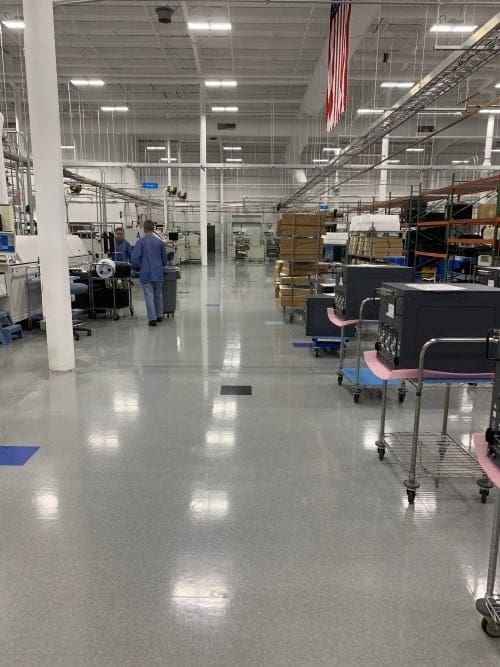
- Clean, hospital-like shine
- Easy to maintain
- No ESD wax, polish or finishes
- Zero measurable VOCs
- FloorScore certified.
- Meets CA 1350/ Indoor Air Quality
- Permanent ESD protection
- No Downtime After Installation
Resistive Characteristics:
Conductive: <1.0 x 10E6
Static dissipative: >1 x 10E6 – <1.0 x 10E9
Floor & Footwear Resistance in Combination with a Person per ANSI/ESD S97.1: < 3.5 X 10E7
Floor & Footwear in Combination with a Person – Voltage per ANSI/ESD S97.2: <25 volts with conductive footwear
Available in dissipative and conductive ranges.
* Static-dissipative by custom order
Thickness: 3 mm or 1/8”
Dimensions: Precision milled 12’ x 12” standard
24” x 24” and 36” x 36” available, custom orders
Generation 3 ESD Coatings & Epoxy
Generation 3 Conductive Epoxy:
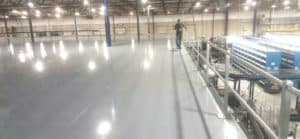
Like ESD vinyl, epoxy and coatings are manufactured using static-generating materials and must be used in conjunction with static-control footwear. Without fully enforced mandates requiring the use of ESD footwear, coatings/epoxy are less effective at mitigating static than static-control rubber or carpet tile. When evaluating coatings for use in ANSI/ESD S20.20 applications, the material should always be tested for charge generation – with the exact ESD footwear that will be used in the space.
Used in conjunction with ESD footwear, Generation 3 epoxy provides the same static-control performance as a high-quality conductive vinyl floor. Generation 2 ESD epoxies, on the other hand, often perform well with full-coverage ESD footwear but poorly with ESD foot straps.
Generation 3 formulations consist of two layers: a) an insulating primer and b) a conductive top coat. Generation 2 ESD epoxy floors require a three-layer formulation that includes a black conductive ground plane directly under the top coat. These three-layer systems usually pass STM7.1 resistance tests (ohms) and fail the ANSI/ESD S97.2 walking voltage test (volts.)
Material cost: $.
Disadvantages: The installer/installation determines the appearance and electrical performance. It is impossible to verify the ESD properties of coatings until after the floor has been installed and the installation has cured. Epoxy and coatings never look as good as they do the day they’re installed.
Generation 2 three-layer systems do not meet ANSI/ESD performance standards.
GroundWorx Ultra
Our premium ESD coating, GroundWorx Ultra provides a beautiful, high-performing static-free surface – for excellent value at a favorable cost point. With a tensile strength exceeding 6,000 pounds, GroundWorx Ultra is extremely durable. It’s easy to install and is quick and cost effective to maintain.
With a material cost < $2 per square foot (< $2.50 with an elevated moisture primer), GroundWorx Ultra gives you a strong, highly durable ESD floor, with optimal ESD performance, at a budget friendly price.
A Generation 3 ESD coating, GX Ultra’s conductive top coat provides consistent ESD properties throughout the space.
Key Benefits
- Durable
- Attractive
- Clear or colorized
- Resists yellowing
- Easy to install
- Reliable
- No buried ground layer
- Installs over most subfloors
- Resists blistering and vapor
- Easy to repair
- Superior ESD performance
- Low tribocharging
- Low cost/high value
- <$2.00 sq/ft
- Durable
- Attractive
- Clear or colorized
- Resists yellowing
- Easy to install
- Reliable
- No buried ground layer

- Installs over most subfloors
- Resists blistering and vapor
- Easy to repair
- Superior ESD performance
- Low tribocharging
- Low cost/high value
- <$2.00 sq/ft
Dissipative: 1.0 x 10E9 ohms
System resistance (w/ESD footwear): <3.5 x 10E7
Body voltage: <15 volts
Learn More
read
- Choosing ESD Flooring for EHMA
- Avoid Costly Failures
- ESD Footwear for EHMA
Choosing ESD Flooring for Electronics Handling and Manufacturing Applications
Standards for ESD floors in electronics manufacturing and handling services (EMS) are stringent. Learn how to choose the best ESD floor for your space.
Avoid Costly Failures: What to Know When Specifying ESD Flooring
Standards vary by industry. Standards for electronics manufacturing and handling differ from those governing telecom, PSAPs, FAA flight towers, and other end-user spaces. To avoid costly mistakes, do due diligence and follow industry protocols.
Static-control Footwear for Electronics Manufacturing and Handling Applications
Under ANSI/ESD S20.20 guidelines, for use in electronics manufacturing and handling facilities, the floor—tested in combination with footwear—must generate no more than 100 volts of static. Without static-protective footwear—toe straps, heel straps, sole straps, or ESD shoes—every flooring material on the market will generate more than 100 volts.
Choosing ESD Flooring for Electronics Handling and Manufacturing Applications
Standards for ESD floors in electronics manufacturing and handling services (EMS) are stringent. Learn how to choose the best ESD floor for your space.
Avoid Costly Failures: What to Know When Specifying ESD Flooring
Standards vary by industry. Standards for electronics manufacturing and handling differ from those governing telecom, PSAPs, FAA flight towers, and other end-user spaces. To avoid costly mistakes, do due diligence and follow industry protocols.
Static-control Footwear for Electronics Manufacturing and Handling Applications
Under ANSI/ESD S20.20 guidelines, for use in electronics manufacturing and handling facilities, the floor—tested in combination with footwear—must generate no more than 100 volts of static. Without static-protective footwear—toe straps, heel straps, sole straps, or ESD shoes—every flooring material on the market will generate more than 100 volts.
Watch
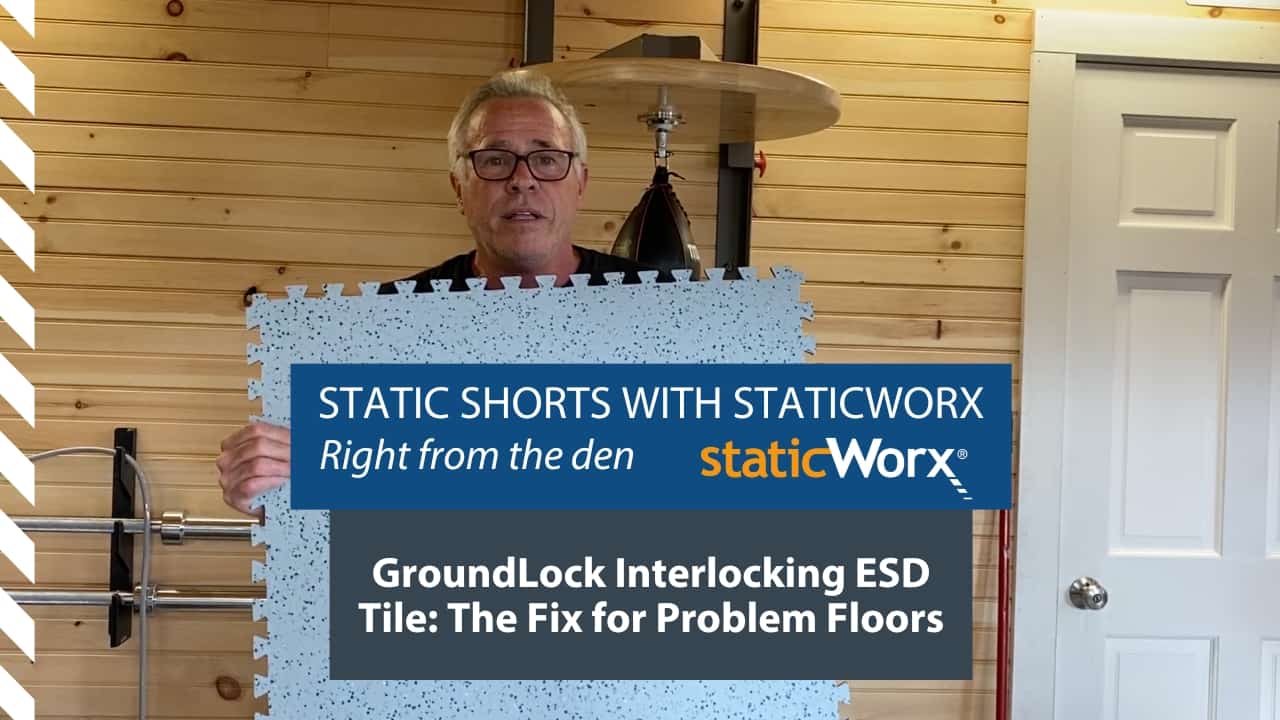

Listen
The Pitfalls of ESD Flooring Selection: How to Avoid ESD Flooring Failure
Three fundamental mistakes account for a majority of ESD flooring failures: selecting the wrong floor for the application: failure to consider total cost of ownership; failing to test the floor after it’s been installed. Avoiding these mistakes helps ensure success. This first of a two-part series on avoiding ESD flooring failures explains why it’s important to select a floor based on the specific application and details the primary considerations that should be taken into account: assessing the type of footwear people will wear in the space and considering goals and objectives, including how the space will be used.
Installing ESD Flooring: Avoiding Pitfalls
The cost of flooring materials is only part of the total cost of ownership. To calculate the long-term cost of owning a floor, consider installation, maintenance, repairs, and downtime required for maintenance and repair. Aesthetics are another consideration. In this podcast, Dave and Rick describe scenarios that occur when people base flooring decisions solely on the cost of the material. Dave also explains why it’s crucial to test an ESD floor immediately after it’s been installed.
Get in Touch
The form below will help us better understand your needs and get you as quickly as possible to the right person. We look forward to helping you solve your static problem!
You can expect a response within 24 hours. For faster service, please give us a call: 617-923-2000
"*" indicates required fields
Visit our privacy policy to find out how we process data.

StaticWorx high-performance static-control floors protect electronic components, explosives, and high-speed computers from damage caused by static electricity. ESD flooring is part of a system. Choices should always be based on objective, researched evidence. When you partner with us, we look at all possible items that may need to integrate with the floor, and, focusing on your goals and objectives, help you find the right floor for your application.








